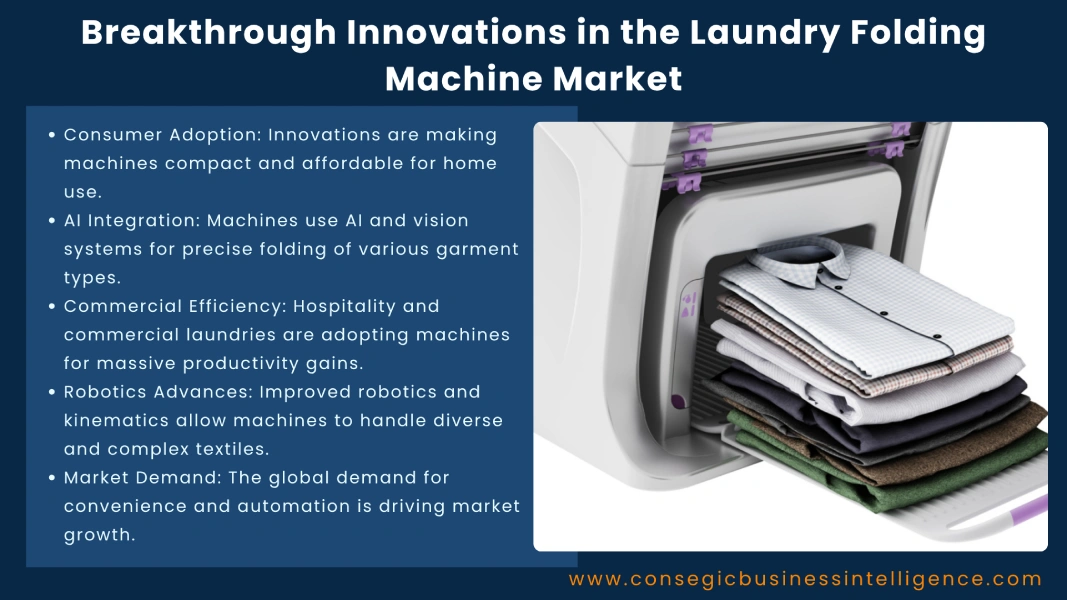Breakthrough Innovations in the Laundry Folding Machine Market
Laundry folding machines, once a futuristic concept, are now becoming a practical solution for modern households, commercial laundries, and hospitality facilities. These machines automate one of the most time-consuming chores like folding clothes, bringing convenience, speed, and precision to textile handling. Initially confined to industrial use, recent innovations have made them compact, intelligent, and user-friendly, enabling adoption in homes and retail spaces.

The global laundry folding machine market is evolving rapidly as advancements in robotics, artificial intelligence (AI), and automation drive smarter and more efficient systems. As consumers and businesses increasingly seek convenience and productivity, new technologies are redefining what these machines can achieve.
Below, we highlight some breakthrough innovations transforming the laundry folding machine market globally.
- AI-Powered Fabric Recognition
One of the most transformative developments in laundry folding machines is the integration of AI-based fabric recognition systems. Using advanced sensors and machine learning algorithms, modern machines can now identify fabric types such as cotton, silk, or denim and automatically adjust folding techniques to suit the texture and thickness. This ensures precise folds, minimizes fabric damage, and enhances garment care for both households and commercial laundries.
- Vision-Based Object Detection and Sorting
Vision processing has significantly improved how laundry folding machines operate. High-resolution cameras and image recognition technologies allow machines to detect garments of different shapes, sizes, and categories. Some advanced models even separate items such as shirts, towels, and trousers before folding, streamlining the workflow and reducing the need for manual sorting. This breakthrough has made fully autonomous folding more achievable in large-scale operations.
- Compact and Modular Designs for Home Use
As automation becomes part of domestic life, manufacturers are focusing on creating space-efficient and modular laundry folding systems. These compact machines fit easily into modern homes and apartments, offering quick setup and easy integration with existing washers and dryers. Many come with collapsible or wall-mounted designs, enabling homeowners to enjoy the benefits of automation without sacrificing valuable space.
- Robotic Arms with Precision Control
Robotic advancements are at the heart of next-generation laundry folding machines. Equipped with multi-axis robotic arms, these machines can mimic human hand movements with remarkable accuracy. Sensors and actuators guide each fold with delicate precision, handling a variety of garments from t-shirts to towels. This innovation enhances speed and accuracy while ensuring consistent folding results, even for delicate fabrics.
- Smart Connectivity and IoT Integration
Connectivity has become a core element of laundry automation. The latest machines are IoT-enabled, allowing users to operate and monitor them through mobile apps or smart home systems. Cloud-based platforms can provide usage analytics, maintenance alerts, and software updates over time. In commercial environments, IoT integration allows centralized control of multiple units, helping facilities manage energy use, productivity, and performance remotely.
- Integration with Laundry Robots and Sorting Systems
Modern laundry management systems are moving toward complete automation by combining washing, drying, sorting, and folding functions. Laundry folding machines are increasingly being integrated with autonomous robots that collect clothes from dryers or conveyor belts and deliver them to folding stations. This seamless workflow eliminates manual intervention and boosts operational efficiency in laundromats, hotels, and textile industries.
- Energy-Efficient and Sustainable Designs
With sustainability at the forefront of modern innovation, laundry folding machines are now being designed to minimize energy consumption and material waste. Manufacturers are adopting lightweight materials, energy-saving motors, and smart power controls. Some advanced models even feature sleep modes and auto shut-off functions when idle. These improvements not only reduce operational costs but also align with global efforts toward energy conservation and eco-friendly appliance design.
- AI-Powered Learning and Customization
The newest generation of folding machines goes beyond basic automation. Through machine learning, these devices can adapt to user preferences over time. They learn from repeated tasks, adjusting fold styles, speed, and stacking methods based on user habits. For commercial users, this customization helps tailor machine behavior to specific garment types, laundry loads, or brand standards enhancing productivity and overall user satisfaction.
- Commercial-Grade High-Speed Folding Systems
In large-scale operations like hotels, hospitals, and uniform services, speed and precision are critical. Modern commercial-grade folding systems can process hundreds of garments per hour with high consistency. These machines combine conveyor systems, robotic handling, and AI-based stacking logic to streamline throughput. Such systems are helping commercial facilities cut labor costs, improve turnaround times, and maintain uniform quality.
- Integration with Smart Home Ecosystems
Laundry folding machines are no longer standalone devices. They’re becoming integral parts of connected home ecosystems. By linking with digital assistants like Alexa or Google Home, users can schedule folds, receive notifications, or even control the machine through voice commands. This integration enhances convenience and brings the vision of a fully automated home closer to reality.
Conclusion
The laundry folding machine market is evolving from a luxury niche into a mainstream solution that blends robotics, AI, and smart design. Innovations such as fabric recognition, robotic arms, compact layouts, IoT integration, and energy efficiency are redefining how clothes are managed in both residential and commercial settings. Meanwhile, advancements in machine learning, smart connectivity, and industrial automation are setting new benchmarks for performance and convenience.
As technology continues to mature, the next generation of laundry folding machines will not only simplify daily routines but also align with sustainable living and intelligent home ecosystems. With these breakthroughs, the industry is well-positioned to revolutionize the way people and businesses approach one of life’s most repetitive tasks which is folding laundry.
